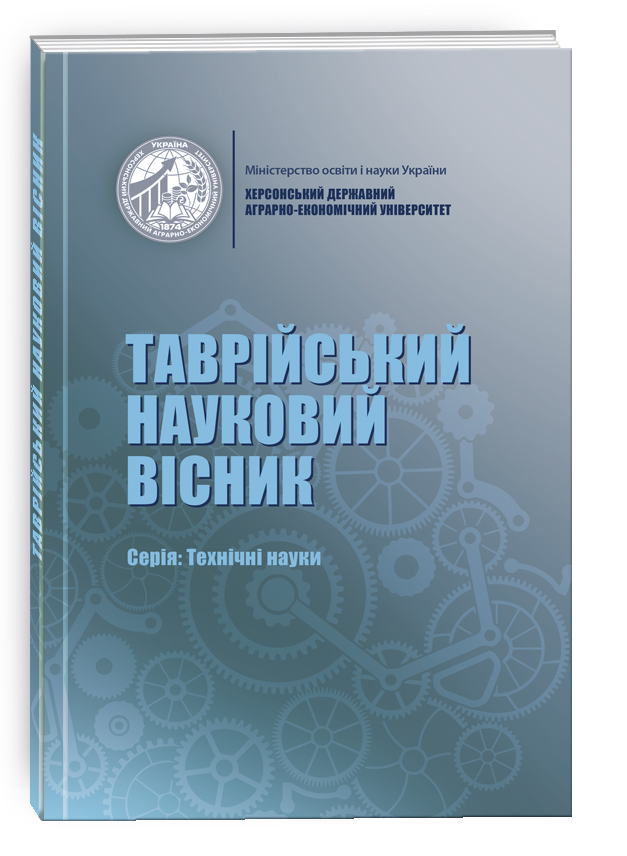RESEARCH OF DEFORMATION PROCESSES IN COMPLEX TECHNICAL STRUCTURES: HYDROTECHNICAL ASPECT
DOI:
https://doi.org/10.32782/tnv-tech.2025.1.55Keywords:
deformation, hydrotechnical structures, engineering structures, strain gauge, measuring deviceAbstract
The main task of sustainable water resources management is to conduct a proper assessment of the technical condition of hydrotechnical structures. Maintaining them in proper condition is a prerequisite for ensuring the safety of the facilities, as well as the territories adjacent to them.To solve this problem, it is necessary to make changes to the safety of hydrotechnical structures. This involves constant monitoring and operational processing of data from control and measuring instruments installed in water bodies. In addition, it is important to analyze compliance with inspection instructions and assess the strength of the structure using innovative methods. In addition, the experience of other countries in this area should be taken into account.A qualified approach to assessing the safety of existing structures is critical to ensuring their continued reliable operation.Hydrotechnical structures play a significant role in the water management of the river. The most popular of them are dams, locks, barriers, and rapids. These structures perform many different functions, including blocking water on the river, regulating the flow, increasing retention, facilitating the use of river transport, and ensuring the safety of nearby areas by protecting them from floods. Dams are also used in the construction of hydroelectric power plants, for which they are an effective barrier against pollution flowing down the river from the catchment area. This problem is especially noticeable in mountainous areas, where there are strong flows of mud and stones that can damage hydromechanical equipment.Measuring the deformation of a structure is one of the two most important elements of assessing the current operational condition of a hydrotechnical facility, which is especially important when the facility is constantly expanding. For this purpose, a device was developed that can be used in the study of relative static and variable deformation, plasticity, creep of samples from various elements of engineering structures, materials, elements, assemblies in hydraulic engineering, construction, and industry.
References
Bestyński, Z., Sieinski, E., & Śliwiński, P. (2022). Geophysical investigation and the use of their results in the evaluation of the stability of slopes of artificial water reservoirs in the flysch Carpathians. Archives of Civil Engineering, 68(No 3), 71–85. https://doi.org/10.24425/ace.2022.141874
Cheng, L., Liu, Y., Pan, Y., Yang, Q., & Lv, Z. (2018). Effective stress law for rock masses and its application in impoundment analysis based on deformation reinforcement theory. Journal of Central South University, 25(1), 218–229. https://doi.org/10.1007/ s11771-018-3731-x
Kuzmych, L. (2007). Development of organizational and technical measures for keeping items of hydrotechnical structures in the good condition. Materials of scientific conference of young scientists. The role of reclamation sustainable development of agriculture, 19–21.
Hämmerling, M., Kocięcka, J., & Zaborowski, S. (2021). AHP as a Useful Tool in the Assessment of the Technical Condition of Hydrotechnical Constructions.
Sustainability, 13(3), 1304. https://doi.org/10.3390/su13031304
Issakhov, A., & Imanberdiyeva, M. (2020). Numerical Simulation of the Water Surface Movement with Macroscopic Particles of Dam Break Flow for Various Obstacles. Water Resources Management, 34(9), 2625–2640. https://doi.org/10.1007/ s11269-019-02382-w
Rokochinskiy, A., Kuzmych, L., & Volk, P. (2023). Handbook of Research on Improving the Natural and Ecological Conditions of the Polesie Zone. IGI Global. https://doi.org/10.4018/978-1-6684-8248-3
Koperska, W., Stachowiak, M., Jachnik, B., Stefaniak, P., Bursa, B., & Stefanek, P. (2021). Machine Learning Methods in the Inclinometers Readings Anomaly Detection Issue on the Example of Tailings Storage Facility. In E. Mercier-Laurent, M. Ö. Kayalica, & M. L. Owoc (Eds.), Artificial Intelligence for Knowledge Management (pp. 235–249).
Springer International Publishing. https://doi.org/10.1007/978-3-030-80847-1_15
Prykhodko, N., Koptyuk, R., Kuzmych, L., & Kuzmych, A. (2023). Formation and Predictive Assessment of Drained Lands Water Regime of Ukraine Polesie Zone. In A.
Rokochinskiy, L. Kuzmych, & P. Volk (Eds.), Handbook of Research on Improving the Natural and Ecological Conditions of the Polesie Zone, 51-74. IGI Global. https://doi. org/10.4018/978-1-6684-8248-3.ch004
Kowalska, M., Zaczek-Peplinska, J., & Piasta, Ł. (2024). Determining the trend of geometrical changes of a hydrotechnical object based on data in the form of LiDAR point clouds. Archives of Civil Engineering, 70(No 1), 305–323. https://doi. org/10.24425/ace.2024.148913
Kuzmych, L., Furmanets, O., Usatyi, S., Kozytskyi, O., Mozol, N., Kuzmych, A., Polishchuk, V. & Voropai, H. (2022). Water supply of the ukrainian Polesie ecoregion drained areas in modern anthropogenic climate changes. Archives of Hydro-Engineering and Environmental Mechanics, 69(1), 79–96. https://doi. org/10.2478/heem-2022-0006
Xujakulov, R., Rahmatov, M., Nabiev, E., & Zaripov, M. (2021). Determination of calculating stresses on the depth of loess grounds of hydraulic structures. IOP Conference Series: Materials Science and Engineering, 1030(1), 012133. https://doi. org/10.1088/1757-899X/1030/1/012133
Zaczek-Peplinska, J., & Saloni, L. (2024). Modernising the control network for determining displacements in hydraulic structures using automatic measurement techniques. Journal of Water and Land Development, 59, 66–75. https://doi. org/10.24425/jwld.2023.147230
Onanko, Yu., Charnyi, D., Onanko, A., Dmytrenko, O., & Kuzmych, A. (2022).
Oil and gas reservoir rock sandstone SiO2 porosity research by internal friction method.
International Conference of Young Professionals «GeoTerrace-2022», 2022, 1–5. https://doi.org/10.3997/2214-4609.2022590062
Kutya, T. V., & Martynyuk, P. N. (2018). Mathematical Simulation of Humidification of Earth on a Slope and Calculation of Its Safety Factor. Journal of Engineering Physics and Thermophysics, 91(5), 1189–1198. https://doi.org/10.1007/ s10891-018-1848-2
Onanko, Y., Kuzmych, L., Onanko, A., Dmytrenko, O., Pinchuk-Rugal, T., Usatyi, S., Il’in, P., & Kuzmych, S. (2025). Influence of irradiation on indicatory surface of anelastic-elastic body of AgZn alloy. Materials Research Express, 12(1), 016516. https://doi.org/10.1088/2053-1591/adabbc
Łydżba, D., Różański, A., Sobótka, M., & Stefanek, P. (2022). Optimization of technological measures increasing the safety of the Żelazny Most tailings pond dams with the combined use of monitoring results and advanced computational models. Archives of Civil Engineering, 68(No 1), 503–518. https://doi.org/10.24425/ace.2022.140182
Onanko, A., Kuzmych, L., Onanko, Y., & Kuzmych, A. (2023). Indicatory surface of anelastic-elastic properties of Ti alloys. Materials Research Express, 10(10),
https://doi.org/10.1088/2053-1591/acfecc
Mazur, R., Stefanek, P., & Orlikowski, J. (2022). Corrosion monitoring as a factor increasing the safety of hydrotechnical infrastructure. Archives of Civil Engineering, 68(No 2), 197–209. https://doi.org/10.24425/ace.2022.140637
Onanko, Y., Kuzmych, L., Onanko, A., Il’in, P., & Kuzmych, A. (2024). Anelastic internal friction and mechanical spectroscopy of SiO2/Si wafers. ECS Journal of Solid State Science and Technology, 13(4), 045001. https://doi.org/10.1149/2162-8777/ ad36e0
Ospanov, N. S., & Krivchenko, A. A. (2021). Description of a 2-Year, High- Resolution Geodetic Monitoring of the Khoko Landslide, Enguri Reservoir, Georgia.
In F. L. Bonali, F. Pasquaré Mariotto, & N. Tsereteli (Eds.), Building Knowledge for Geohazard Assessment and Management in the Caucasus and other Orogenic Regions (pp. 301–316). Springer Netherlands. https://doi.org/10.1007/978-94-024-2046-3_16
Onanko, A. P., Kuryliuk, V. V., Onanko, Y. A., Kuryliuk, A. M., Charnyi, D. V., Dmytrenko, O. P., Kulish, M. P., Pinchuk-Rugal, T. M., & Kuzmych, A. A. (2022).
Mechanical spectroscopy and internal friction in SiO2/Si. Journal of Nano- and Electronic Physics, 14(6), 06029. https://doi.org/10.21272/jnep.14(6).06029
Ospanova, D., Dauletmuratova, N., & Aytmuratov, B. (2024). The results of the study on the technical condition of hydraulic structures in reservoirs. E3S Web of Conferences, 524, 02002. https://doi.org/10.1051/e3sconf/202452402002
Onanko, A. P., Kulish, M. P., Lyashenko, O. V., Prodayvoda, G. T., Vyzhva, S. A., & Onanko, Y. A. (2012). Inelastic-elastic properties of SiO2, SiO2 + TiO2 + ZrO2. 2012 IEEE International Conference on Oxide Materials for Electronic Engineering (OMEE), 2012, 81–82. https://doi.org/10.1109/OMEE.2012.6464790
Połomski, M., & Wiatkowski, M. (2024). Evaluation of the functionality of seepage prevention structures of dam bodies after a long period of operation – a case study of Otmuchów and Nysa reservoirs. Archives of Civil Engineering, 70(No 3), 153–171. https://doi.org/10.24425/ace.2024.150976
Stefaniak, K., & Wróżyńska, M. (2017). On possibilities of using global monitoring in effective prevention of tailings storage facilities failures. Environmental Science and Pollution Research, 25(6), 5280–5297. https://doi.org/10.1007/ s11356-017-0995-x







